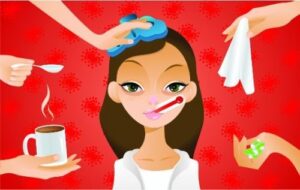17 ЯНВАРЯ — ДЕНЬ ПРОФИЛАКТИКИ ГРИППА И ОРЗ
Грипп (фр.grippe) — это острое инфекционное заболевание дыхательных путей, вызываемое вирусом гриппа.
Слово «грипп» в переводе с французского означает «схватывать». Таким образом, даже название говорит о коварном характере заболевания.

Грипп распространяется в виде эпидемий и пандемий. В настоящее время выявлено более 2000 вариантов вируса. В большинстве случаев Гриппа заболевание вызывают вирусы гриппа типов: А, В, C.
Пути передачи вируса гриппа от человека к человеку очень просты и незаметны: разговор, кашель, чихание и риск заразиться есть у каждого человека. Самый высокий риск распространения инфекции в детских коллективах. Самой легкой добычей гриппа становятся люди с ослабленным иммунитетом.
Грипп опасен осложнениями, и ни одна другая инфекция не дает такого количества осложнений!
После гриппа могут возникнуть:
1. Осложнения дыхательной системы: пневмония (может быть как вирусная, так и бактериальная), трахеобронхит.
2. Осложнения сердечно-сосудистой системы: коллаптоидное состояние, миокардит вирусной природы, понижение артериального давления.
3. Нервно-сосудистые осложнения: энцефалопатия, менингоэнцефалиты, менингиты.
4. Осложнения на фоне вторичной инфекции – ангина, гайморит, нефрит, пневмония.
5. Инфекционно-токсический шок.
6. Обострения хронических заболеваний. Именно эти осложнения являются непосредственной причиной летального исхода после перенесенного гриппа.
Чтобы оградить себя и своих близких от заболевания гриппом и его тяжелых последствий, следует соблюдать меры профилактики.
К мерам профилактики можно отнести:
Вакцинация — основной и наиболее эффективный метод профилактики. Она не гарантирует стопроцентную защиту от гриппа, но либо предупреждает возникновение заболевание, либо оно протекает легко и без осложнений. Иммунитет к вирусу сохраняется от полутора до 8-10 месяцев.
Неспецифические лекарственные средства. К ним относятся иммуномодуляторы, витамины, средства стимулирующие выработку интерферона. Применяются в момент эпидемии гриппа. Данные препараты назначается лечащим врачом с учетом индивидуальных особенностей организма пациента.
Немедикаментозные методы.
• Избегать близкого контакта с людьми, которые кажутся нездоровыми, обнаруживают явления жара (температуры) и кашель;
• Соблюдать гигиену рук – чаще мыть руки водой с мылом или использовать средство для дезинфекции рук на спиртовой основе, особенно в случае прикосновения ко рту, носу;
• Избегать многолюдных мест или сократить время пребывания в многолюдных местах;
• Стараться не прикасаться ко рту и носу;
• Использовать защитные маски при контакте с больным человеком;
• Увеличить приток свежего воздуха в жилые помещения, как можно чаще открывать окна;
• Придерживаться здорового образа жизни: полноценный сон, рациональное питание, физическая активность, регулярные прогулки на свежем воздухе. Ежедневные прогулки на свежем воздухе, проветривание помещений дома и на работе.
